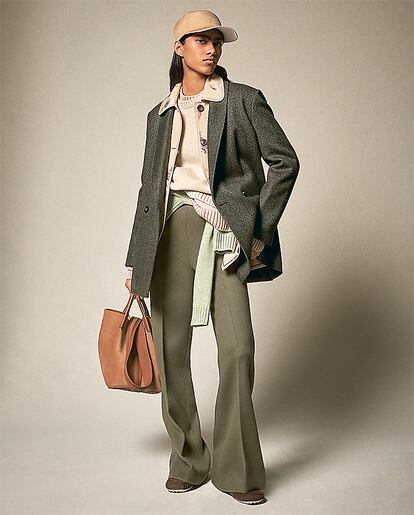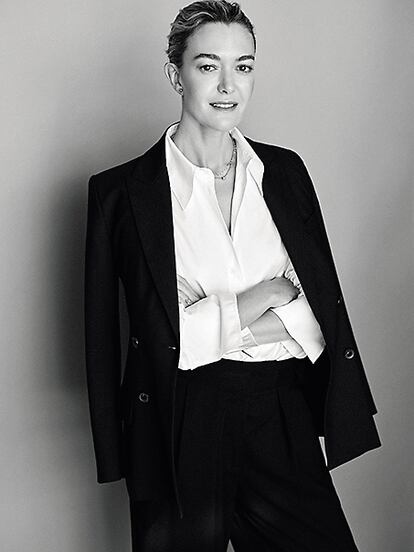What if silent luxury was not a trend, but a symptom of a shift in the fashion industry?
Welcome to the era of ‘If you know, you know.’ The era of luxury, in which the ultra-rich dress to impress other rich people and boast about how much they understand fashion

Let’s try a game this fall. Let’s go to the golden mile of any city and look at what passers-by are wearing. We may see a hoodie, gray trousers with waist pleats, the occasional beige sweater and, perhaps, the most daring might wear a Nirvana t-shirt. A style that does not attract too much attention, and that, although it looks neat, does not shout “This cost a lot of money.” Wrong. All these garments are anything but humble. The sweatshirt has a Miu Miu label and costs about €1,300 ($1,404), the gray pants are from Fendi and are sold for €850 ($918), the cashmere sweater was designed by Brunello Cucinelli and does not fall below €1,500 ($1,620) ... and the Nirvana Incesticide t-shirt, in a tremendous flip of the script, is really a Saint Laurent and its price tag is no less than €3,550 ($3,781). Welcome to the era of ‘If you know, you know’ in luxury, in which the ultra-rich dress so that other rich people recognize all the money they are wearing. And to brag about how much they understand fashion.
The truth is that it is not something new. Historically, the privileged classes have used codes that were incomprehensible to the uninitiated with the idea of recognizing each other and preventing impostors without a pedigree from infiltrating their ranks. The difference today is that this superlative snobbery has become visible to the general public. The trigger was the HBO series Succession, in which the plutocrats compensated for their dark motivations with wardrobes in infinite shades of camel. But it is not only in fiction that we can glimpse the brushstrokes of this look. In each of Marta Ortega’s public appearances the challenge is to see if she is dressed in ‘Zara next season’ or brands so exclusive that ordinary mortals are unaware they even exist. Globally, Gwyneth Paltrow’s images at her skiing accident trial were the best marketing campaign for her own brand G. Label by Goop. During her court appearances Paltrow gave a master class in the look that the TikTok influencer Tinx calls “rich mother.” The formula consists more or less of Goop pieces plus preppy accessories such as aviator glasses by Ray-Ban and a vintage bag by Celine, with high-fashion touches from brands such as The Row and Prada. These popular culture moments, combined with the photos of Silicon Valley billionaires in their well-fitting T-shirts, have us obsessed with so-called silent luxury, albeit with a mixture of fascination and rage.

“Fashion always maintains a dialogue with the cultural context, and at this time we are aware that there are people who can’t make ends meet, so it is inappropriate to flaunt one’s wealth openly. However, fashion always finds ways to give meaning to a certain style,” explains Mira Kopolovic, director dedicated to cultural analysis at the creative agency for social networks We Are Social. “In response to the cost-of-living crisis, we have identified a cultural trend that we call “the knowledge flex,” which is how people reveal information about their status not only with what they own, but also with what they know.” Taking into account the different types of capital established by the sociologist Pierre Bourdieu, dressing in expensive and yet boring clothes, in addition to granting cultural capital among the like-minded, also incorporates other capitals: economic (purchasing power) and social (connections).
“We are facing a very sophisticated type of luxury consumer who avoids logos and wears only recognizable labels for those who play at the same level,” says James Collard, a journalist specializing in luxury. “I have noticed that many Italians with money have stopped wearing the most obvious names and opt for others such as Aspesi who are little known [outside of wealthy circles]. And when, for professional reasons, I met an extremely rich individual, I thought that if we saw them at Starbucks we would have no idea of the fortune they have in the bank. They weren’t wearing obviously exclusive clothes, or an expensive watch.”
Meanwhile, the best-known fashion brands have designed their collections for the autumn-winter 2023-2024 season around this trompe l’oeil game. It says a lot that for this autumn-winter season Gucci has left maximalism aside and is going with jeans with white shirt and unadorned trench coats instead; and Bottega Veneta has reached the culmination of the false basic with denim-look pants that are actually made of a very fine printed leather.
“Luxury brands such as The Row and Bottega Veneta, which have always emphasized craftsmanship and timelessness in their collections, are joining in this trend, as are Valentino, Miu Miu and even Balenciaga. These last brands, which in previous collections sought to go viral with advertising tricks, are today showing their products in discreet, elegant environments, which convey the quality and durability of their pieces,” says trend analyst Agustina Panzoni (The algorithm, on TikTok). “This season’s fashion collections could usher in a shift in the industry away from viral product fever. Instead of creating pieces meant to make noise on social media and disappear quickly, designers might be opting for designs that stay relevant for several seasons.”
It is common to find the arguments that identify the rise of this style with changes emerging in the industry that have to do with the end of the deranged cycle of trends. This would imply that the phenomenon is not just a trend. “Many firms are clearly anticipating that their customers will adopt this way of dressing in the long term,” says Libby Page, purchasing director at Net-A-Porter. “For me, that look has materialized in The Row’s undercut heels, Khaite’s straight jeans, ATM Anthony Thomas Melillo T-shirts, topped with a Loro Piana cashmere cap.”
The cap, which Kendall Roy did not take off in Succession while dealing with his multiple torments, is the maximum exponent of this aesthetic. With a price of about €420 it is one of the most popular products of the second quarter of 2023, according to The Lyst Index. Its online success has boosted the popularity of an until now strictly minority brand, with a 35% increase in searches on fashion shopping platform Lyst for Loro Piana from May to June. According to Google Trends, during the summer there was a notable increase in searches for terms related to this aesthetic: a rise of 300% of global searches for “stealth wealth,” and 80% for “old money style,” that is, long-established wealth, the opposite of a nouveau riche.

If we look at this information carefully, it might seem that the average fashion consumer has decided to dress like a super-boring oligarch, and that any type of fun tones have been banished. But here comes the uncomfortable question for the industry. What happens when what you seek to hide goes viral? An elitist style survives in relative anonymity. As soon as it is leaked to the mass market, it loses its appeal and usefulness for those who use it. When even some mid-priced brands are advertising their products on Instagram under the label of silent luxury (what irony), the natural consequence is for the prestige of certain styles to decline.
But taking a tour of social networks we realize that the younger generation are going further, and in addition to popularising what was previously a style only for those in the know, they are subverting the codes and neutralizing its most classist connotations. “Class signals in the ‘old money core’ have been democratized online so that they have become a symbolism that anyone can inhabit,” Kopolovic argues. “Young people have learned to alter power dynamics, and they are causing this style to lose its symbolic power. Something similar happened when the British working class youth appropriated the iconic Burberry print. Also, that these labels are popular on the internet, does not mean that generation Z wants to dress in a minimalist style. The cores (or aesthetics that are born online) are the lenses through which youth processes culture. They tell us about their values and how they relate to economic realities in general,” Kopolovic concludes.
When luxury monopolizes the concept of quality and durability, it is the consumer’s turn to claim conscious fashion without spending a fortune. It is possible to buy from independent designers with social responsibility and without having to remortgage the house. You can make the garments last by taking care of them and repairing them. There are small brands that avoid unnecessary expenses by producing collections to order, without having to create an artificial exclusivity. In support networks and communities, clothing is donated or lent to extend the life of the garments. In short, you do not have to dress with as little joy as Shiv Roy to avoid falling into unbridled consumption.
The concept of timelessness could also be questioned. Because the silhouettes of the seemingly basic clothes, which we wear on a daily basis, are actually more subject to the vagaries of trends than we think. It is likely that, despite the label of ‘classics,’ your cut or silhouette will become obsolete much sooner than you think.
And perhaps, by taking the opposite to the prevailing thing, it is possible that eccentric delights are longer in the long run. Gold platforms, a green floor-length dress, colored stone earrings... These pieces may stay with us for longer and bring us more pleasure in our lives than a happy and expensive beige sweater.
Sign up for our weekly newsletter to get more English-language news coverage from EL PAÍS USA Edition
Tu suscripción se está usando en otro dispositivo
¿Quieres añadir otro usuario a tu suscripción?
Si continúas leyendo en este dispositivo, no se podrá leer en el otro.
FlechaTu suscripción se está usando en otro dispositivo y solo puedes acceder a EL PAÍS desde un dispositivo a la vez.
Si quieres compartir tu cuenta, cambia tu suscripción a la modalidad Premium, así podrás añadir otro usuario. Cada uno accederá con su propia cuenta de email, lo que os permitirá personalizar vuestra experiencia en EL PAÍS.
¿Tienes una suscripción de empresa? Accede aquí para contratar más cuentas.
En el caso de no saber quién está usando tu cuenta, te recomendamos cambiar tu contraseña aquí.
Si decides continuar compartiendo tu cuenta, este mensaje se mostrará en tu dispositivo y en el de la otra persona que está usando tu cuenta de forma indefinida, afectando a tu experiencia de lectura. Puedes consultar aquí los términos y condiciones de la suscripción digital.
More information
Archived In
Últimas noticias
Most viewed
- Sinaloa Cartel war is taking its toll on Los Chapitos
- Oona Chaplin: ‘I told James Cameron that I was living in a treehouse and starting a permaculture project with a friend’
- Reinhard Genzel, Nobel laureate in physics: ‘One-minute videos will never give you the truth’
- Why the price of coffee has skyrocketed: from Brazilian plantations to specialty coffee houses
- Silver prices are going crazy: This is what’s fueling the rally










































